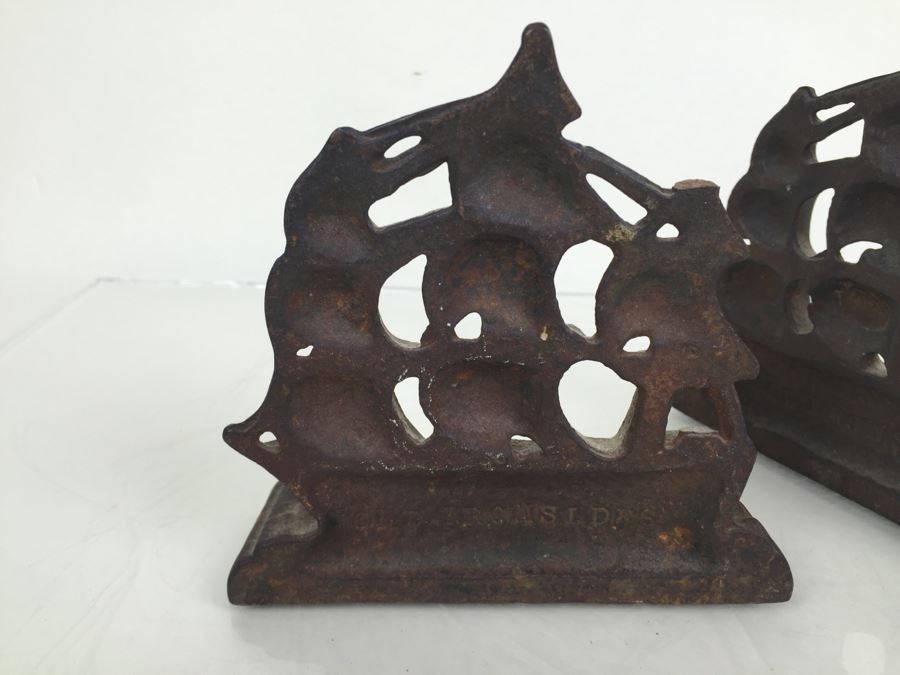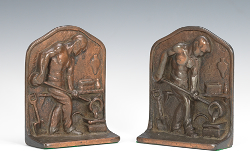

There were few canine breeds overlooked by Hubley, and in each case, great attention was paid to the small details. Many subjects were depicted in Hubley’s doorstops, and they were especially well known for their dogs. Molds were used in the mass production of doorstops, but each was painted by hand. Applying some of the techniques and processes used to produce cast-iron toys proved profitable for Hubley when it ventured into doorstops.

Hubley cast iron toy vehicles were popular when they were new, and are even more so today as collectors’ items. Hubley was an early manufacturer of cast iron toys. Located in a region known for iron mining during the 19th century, it’s no wonder that in 1894 the Hubley Manufacturing Company in Lancaster, Pennsylvania, would become involved in cast iron production. Bertoia Auctions and LiveAuctioneers image Huckleberry Finn-type whistling boy figure cast-iron doorstop, detailed casting, both rubber knobs intact, good retention of paint, from the Jeanne Bertoia Collection, sold for $22,420 during a March 2016 auction at Bertoia Auctions. Although it’s hard to determine precisely when the Bradley and Hubbard division of the Parker Company ceased to operate, but by 1950 there was no longer any mention of the division in the company’s product catalogs. The company was sold to Charles Parker Company in 1940. In the years that followed, the company became a leader in the production of kerosene lamps and architectural elements, including grilles, railings, fences, doorstops, and lighting fixtures. The company also made flags, hoopskirts and match safes, all within the first few years of operation. While production of clocks remained the company’s top priority, they expanded operations to manufacture call bells and sewing machines. Just two years later, the Hatch brothers stepped away, leaving the Bradley brothers and Hubbard to move forward as Bradley and Hubbard.

Bradley, Walter Hubbard, and Orson and Chitten Hatch formed a partnership in 1852, the focus of their output was clocks.

Here we’ll look at the contributions each made to doorstop history. Also, one of the revered designers of doorstops was Anne Fish. Among the most prolific producers were Bradley & Hubbard, Hubley, Littco, and Judd Co. Several companies have produced doorstops over the past two centuries, and in many instances, doorstops were a secondary, albeit successful, sideline. A perfect example of crossover collectibles, figural doorstops boast designs related to everything from Americana, nautical and floral themes to entertainment characters, folk art, animals and nature.ĬOLLECTING TIP – Many vintage models of original doorstops have a smoother casting, as opposed to a rougher surface that is sometimes seen in reproductions. The versatility of figural doorstop design also lends to its appeal among collectors of other types of objects. Sought-after hand painted casting of a young girl stepping over flowers, strong retention of paint, one of many variations of this doorstop created by Littco Productions (est. As was the case with more than a few objects of the past, being utilitarian didn’t mean visual appeal had to be sacrificed. The first doorstops were not fanciful in design, but it didn’t take too long before figural images became standard in doorstop production. Enter the doorstop.ĭoorstops of brass or other metals were commonplace in the early part of the 18th century, but it was the use of cast iron in the production of doorstops that changed the trajectory of stops, also known as chucks, wedges and blocks, among other things. A door that closed by itself was undoubtedly a helpful innovation, however, there were times when an open door was necessary and desired. Charles Dickens once wrote, “A very little key will open a very heavy door.” And a small cast-iron doorstop can keep it ajar while also being stylish and collectible.Īccording to the Encyclopedia Britannica, the advent of modern cast-iron doorstops came about in the mid-18th century, when a type of hinge was added to doors to allow for automatic closure.


 0 kommentar(er)
0 kommentar(er)
